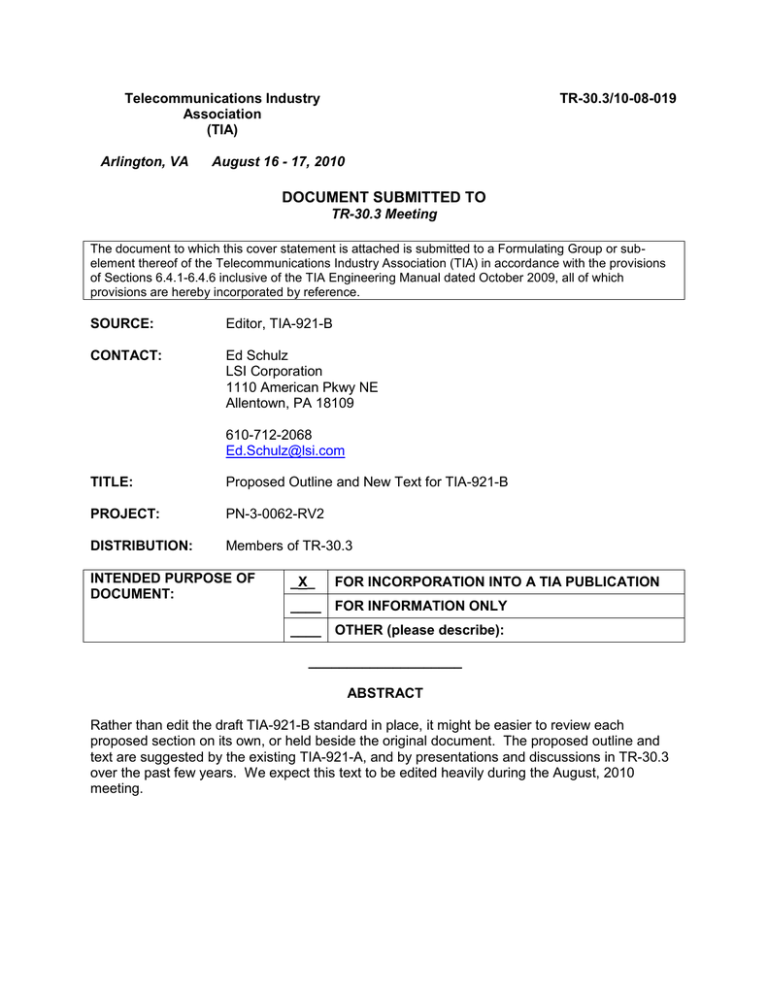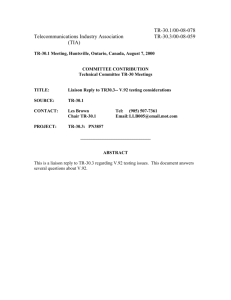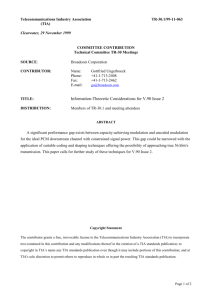Telecommunications Industry Association
advertisement

Telecommunications Industry Association (TIA) Arlington, VA TR-30.3/10-08-019 August 16 - 17, 2010 DOCUMENT SUBMITTED TO TR-30.3 Meeting The document to which this cover statement is attached is submitted to a Formulating Group or subelement thereof of the Telecommunications Industry Association (TIA) in accordance with the provisions of Sections 6.4.1-6.4.6 inclusive of the TIA Engineering Manual dated October 2009, all of which provisions are hereby incorporated by reference. SOURCE: Editor, TIA-921-B CONTACT: Ed Schulz LSI Corporation 1110 American Pkwy NE Allentown, PA 18109 610-712-2068 Ed.Schulz@lsi.com TITLE: Proposed Outline and New Text for TIA-921-B PROJECT: PN-3-0062-RV2 DISTRIBUTION: Members of TR-30.3 INTENDED PURPOSE OF DOCUMENT: _X_ FOR INCORPORATION INTO A TIA PUBLICATION ____ FOR INFORMATION ONLY ____ OTHER (please describe): ____________________ ABSTRACT Rather than edit the draft TIA-921-B standard in place, it might be easier to review each proposed section on its own, or held beside the original document. The proposed outline and text are suggested by the existing TIA-921-A, and by presentations and discussions in TR-30.3 over the past few years. We expect this text to be edited heavily during the August, 2010 meeting. TR-30.3/10-08-019 Foreword [From the TIA Style Manual, 1992!] The foreword shall appear in every standard; it consists of a general part giving information relating to the organization responsible and to standards in general and a specific part giving as many of the following as are appropriate: -- an indication of the committee that prepared the standard; -- information regarding the approval of the standard; -- an indication of any other organization that has contributed to the preparation of the standard; -- a statement that the standard cancels and replaces other documents in whole or in part; -- a statement of significant technical changes from the previous edition of the standard; -- the relationship of the standard to other standards or other documents; -- a statement of which annexes are normative and which are informative. (e.g., There are two annexes in this Standard. Annex A is normative and is considered part of this Standard; Annex B is informative and is not considered part of this Standard.) The following disclaimer shall appear above the text: (This foreword is not part of this Standard.) ANSI-accredited committee TR-30.3 has developed this TIA-921-B Standard, which defines an IP network model. This model, along with the specified scenarios, are intended for evaluating and comparing communications equipment connected over a converged network. Building upon the experience of creating network nodels, TR-30.3 Subcommittee has created this Network Model for IP Impairments using the similar methodology developed in its previous standards and bulletins: EIA/TIA-496-A-1989: Interface Between Data Circuit Terminating Equipment (DCE) and the Public Switched Telephone Network, which includes a Network Model for Evaluating Modem Performance TIA TSB-37-A-1994: Telephone Network Transmission Model for Evaluating Analog Modem Performance, which became ITU-T Recommendation V.56bis-1995 TIA TSB-38-1994 (and TSB-38-A -2007): Test Procedures for Evaluation of 2-Wire 4 Kilohertz Voice Band Duplex Modems, which became ITU-T Recommendation V.56ter1996 ANSI/TIA/EIA-3700-1999: Telephone Network Transmission Model for Evaluating Analog Modem Performance ANSI/TIA/EIA-793-2001: North American Telephone Network Transmission Model for Evaluating Analog Client and Digitally Connected Server Modems ANSI/TIA-876-2002: North American Network Access Transmission Model for Evaluating xDSL Modem Performance TIA-921-B was approved on [insert date]. It cancels and replaces TIA-921-A (2008) in its entirety. Technical changes from TIA-921-A include: TIA-921-B models the mechanisms that contribute to packet delay, jitter, and loss: interfering streams, queueing delays in network elements, and the characteristics of specific access technologies. This should provide more realism than the earlier version. TIA-921-A defined a mathematical model that fit certain observed network behavior, but was not easily extended to other scenarios. The “likelihood of occurrence” concept is no longer applied to IP networks. TIA-921-B is a true bidrectional model. Impairment levels are updated to keep current with evolving IP networks. The number of standard test cases is greatly reduced. Users can customize test cases to fit their specific needs. Page 2 of 8 TR-30.3/10-08-019 There are [insert number] of Annexes in this Standard. Annex A [and Annex B] are normative and are considered part of this Standard. Annex [C and Annex D] are informative and are not considered part of this Standard. Introduction [From the TIA Style Manual] The introduction is an optional preliminary element used, if required, to give specific information or commentary about the technical content of the standard and about the reasons prompting its preparation. It shall not contain requirements. TIA-921-B describes a model of Internet Protocol (IP) networks for the purpose of evaluating the performance of IP streams. The focus is on packet delay, delay variation, and loss. IP streams from any type of network device can be evaluated using this model. Emphasis is given to the fact that manufacturers of communications equipment and service providers are interested in a specification that accurately models the IP network characteristics that determine performance. Evaluators desire a definitive set of simple tests that properly measure the performance of communications devices from various manufacturers. Therefore, the objective of this standard is to define an application-independent model (e.g. data, voice, voiceband data, and video) that is representative of IP networks, that can be simulated at reasonable complexity, and that facilitates practical evaluation times. The IP network model presented herein represents a snapshot of actual network data provided by anonymous IP service providers and IP network equipment manufacturers in the 2010 timeframe, and will continue to evolve as more statistical information becomes available and as the IP network evolves. Scope [From the TIA Style Manual] This element shall appear at the beginning of every standard to define without ambiguity the subject of the standard and the aspect(s) covered, thereby indicating the limits of applicability of the standard or particular parts of it. It shall not contain requirements. This Standard is broadly applicable to the evaluation of any equipment that terminates or routes traffic using Internet Protocol. This Standard can also be used to evaluate media streams or other protocols carried over IP networks. Examples of the types of equipment that can be evaluated using this model include: IP-connected endpoints: o IP Network Devices (such as: User Agents, Call Agents, Media Servers, Media Gateways, Gatekeepers, Application Servers, Routers, etc.) o IP Video (IPTV, video conferencing, telepresence, etc.) o IP Phones (including soft phones) o IAF (Internet Aware Fax) o core network elements PSTN-connected devices through IP gateways: o POTS through Voice-over-IP (VoIP) gateways o T.38 facsimile devices and gateways o V.150.1 and V.152 (voiceband data, VBD) modem-over-IP gateways o TIA-1001 and V.151 textphone-over-IP gateways The IP network model can be used in two ways: Page 3 of 8 TR-30.3/10-08-019 Test an IP stream under simulated network conditions Test an IP stream in real time using hardware emulation of the network model. Whether in software simulation or real-time hardware emulation, users can select from several test cases specified in this Standard. Users can optionally define their own test cases. This model has the following limitations: Some VoIP networks may utilize PSTN at one or both ends of the connection through a media gateway. This model only addresses the IP portion of the network and does not address the PSTN portion of the end-to-end connection. The network model represented in this Standard does not model all possible connections that can be encountered between devices. The IP network model presented herein is based on an informal survey of anonymous IP service providers and IP network equipment manufacturers in the 2010 timeframe and will continue to evolve as more statistical information becomes available and as the IP network evolves. Description of the Model Overview The new IP network model of this Standard is embodied in a discrete event software simulator. In a real sense, the simulator is the model. Other implementations are possible, including realtime hardware network emulators for test lab use, but their behavior must match that of the simulator presented here. The IP network is modeled as a network of basic elements. Figure 1 shows the basic network element, called a “switch.” Disturbance Load Generator Second Disturber Third Disturber Test Stream Input to This Stage Link Latency + Simulated Packet Queue with Loss Test Stream Output from This Stage Disturbance Packets Figure 1: Model Basic Network Switch Element The basic network elements are “wired” in series into a specific network topology. One such possible network is shown in Page 4 of 8 TR-30.3/10-08-019 [insert line drawing of slide 12] This is an outline of the simulator processing: 1. A packet generator drives packets into the simulator. The arrival times and sizes of the test stream packets and the interfering stream packets are read from pcap files. 2. A switch receives packets on its ingress ports, and determines where packets should go next. 3. A switch schedules each packet for transmission out one of its egress ports. 4. Wires connect the egress port of one switch to the ingress port of another switch. 5. The process repeats for all packets through all switches and wires. 6. Packet arrival and departure times are stored in a file for analysis. The sections that follow explain the components of the model in more detail: Disturbance Load Files Network Topology Models of Network Elements Simulation Inputs [do we need this subsection?] Simulation Outputs Packet Scheduling Algorithm Disturbance Load Files [where they came from] [how selected] [bidirectional] [how processed: strip payload (or not), optionally scaled, optionally smoothed] [how described by time series, PDV histogram] [QoS assigned as managed or residual bandwidth (or does that below elsewhere in the Standard?)] [impairment severity is a function of pcap statistics, number and rate of streams] Network Topology [standard models: LAN-LAN, core-LAN, core only] [impairment severity is a function of the number of stages] [how to describe custom models] Models of Network Elements Network Element Overview The various types of networks elements considered in this model are: switch router firewall access link and devices [cut this list to the bare minimum required] [Is there really any interesting difference among these elements, or can they all be modeled as a switch?] Page 5 of 8 TR-30.3/10-08-019 Switch Router Firewall Access Technologies Access Technology Overview The model accounts for the different properties of different access technologies. The parameters of interest, all of which affect the impairment severity, include: link rate bit-error rate delay DCE buffer size QoS [insert noun] Digital Subscriber Line DSL data rates are between 10 Mbit/s and 33 Mbit/s. [What about upstream?] DSL bit-error rates are between 10-8 and 10-7. The data buffer size at the DSL modem is assumed to be 64 kBytes. Cable Modem Gigabit Passive Optical Network (GPON) Wireless Access (WiMAX, LTE) Simulation Inputs [Do we need this section, or can we include everything within the preceding subsections?] Simulation Outputs The simulator output is a file for each direction – upstream and downstream – that lists the precise arrival time and delay of each packet in the stream under test from model ingress to egress. Packets that are dropped because of network congestion are noted. [What does Delay mean when the packet is dropped?] See the example in Table 1. Page 6 of 8 TR-30.3/10-08-019 Table 1: Example Simulator Output Source: Creation Date: Description: ContentEncoding : Delay Unit: Time 2 2.064531 2.068719 2.083353 2.103442 2.129744 2.136147 2.160704 2.276267 2.306837 2.331988 2.36096 2.443818 TIA-921-B 5/5/2010 Misc Downstream 2 ASCII ms Delay 62.540836 62.5377494 62.106312 62.21563497 62.40617898 62.154648 62.401416 63.0072554 62.69638617 63.43353741 62.41461574 62.09868 63.41120351 Drop 0 0 0 0 0 1 0 1 1 1 1 1 0 The simulator may generate a pcap file containing the same information, suitable for processing by any program that recognizes the pcap file format. [Should examples of PDV and time series be included here, or in an informative Annex?] Packet Scheduling Algorithm [Chip Webb will provide this text.] IP Network Impairment Level Requirements [Insert Y.1541 table of test profiles and SLAs.] [Insert tables of impairment levels.] Annex (Normative): Description of Discrete Event Simulator [or is this really the core part of the standard, and as such, should be in the main body, not in an Annex?] Annex (Normative): C++ Source Code of Discrete Event Simulator [electronic attachment] [Should the source itself be printed in the document?] Page 7 of 8 TR-30.3/10-08-019 Annex (Normative): Packet Capture Files of Interfering Traffic [electronic attachments] Annex (Normative): Simulator Output [electronic attachments] Annex (Informative): Rationale for Network Model Annex (Informative): ____________________ Page 8 of 8







